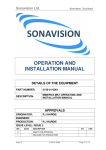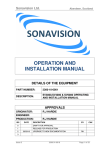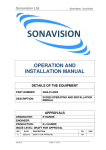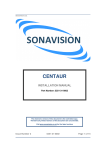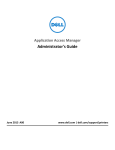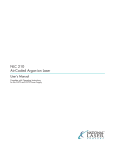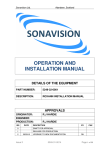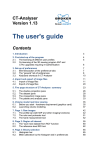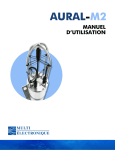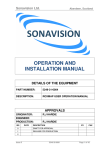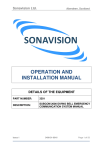Download OPERATION AND INSTALLATION MANUAL
Transcript
Sonavision Ltd. Aberdeen, Scotland OPERATION AND INSTALLATION MANUAL DETAILS OF THE EQUIPMENT PART NUMBER: 2393-01-0001 DESCRIPTION: TITAN SONAR OPERATING AND INSTALLATION MANUAL APPROVALS ORIGINATOR: ENGINEER: PRODUCTION: ISS DATE R.J HARDIE R.J HARDIE DESCRIPTION BY 0 DRAFT FOR APPROVAL 1 RELEASE FOR PRODUCTION CHK 2 Issue 3 2393-31-0020 Page 1 of 18 Sonavision Ltd. 3 31/03/10 Aberdeen, Scotland UPGRADE TO NEW DOCUMENTATION RH 4 5 The latest issue of this document is held in electronic form. This is available from our website www.sonavision.co.uk COPYRIGHT © SONAVISION LIMITED AUGUST 2008 The copyright in this document is the property of Sonavision Limited. The document is supplied by Sonavision Limited on the express terms that it may not be copied, used, or disclosed to others except as authorised in writing by Sonavision Limited. Sonavision Limited reserves the right to change, modify and update designs and specifications as part of their ongoing product development programme. TECHNICAL SUPPORT Address Sonavision Limited Unit 12 Energy Development Centre Aberdeen Science and Energy Park Bridge of Don Aberdeen AB23 8GD Scotland Telephone +44 (0)1224 707737 Fax +44 (0)1224 827290 Email [email protected] Website www.sonavision.co.uk Issue 3 2393-31-0020 Page 2 of 18 Sonavision Ltd. Aberdeen, Scotland MAINTENANCE AND WARRANTY POLICY Sonavision Limited warrants that its products are free from defects at the time of delivery and subject to the conditions listed below, undertakes to repair, or at its option replace, any product found to be defective in material or workmanship within one year after delivery, whichever is less, to the original purchaser by Sonavision Limited or its authorised representative. CONDITIONS 1. Sonavision Limited must be immediately notified of any suspected defect and if advised by Sonavision Limited, the equipment subject to defect shall be returned to Sonavision Limited, freight prepaid. 2. This warranty does not cover defects which are caused as a result of improper usage, repair, maintenance, alteration or installation unless such activities have been undertaken by Sonavision Limited or its authorised representative. 3. On completion of any warranty work, Sonavision Limited will return the equipment, freight prepaid. 4. Sonavision Limited retains the sole right to accept or reject any warranty claim. SAFETY AND ENVIRONMENTAL STATEMENT 1. Lethal voltages are exposed within the control unit when the top cover is removed. The unit should always be disconnected from the mains supply before removing or operating any internal components. 2. The unit should be earthed at all times. 3. The unit contains electrostatically sensitive devices (ESSD). Appropriate static protection should be used when handling subassemblies. RELATED DOCUMENTS Document Number Issue 3 Document Title 2393-31-0020 Page 3 of 18 Sonavision Ltd. Aberdeen, Scotland TABLE OF CONTENTS Section 1.0 INTRODUCTION AND SPECIFICATION 1.1 INTRODUCTION 1.2 SPECIFICATION 1.3 GENERAL ARRANGEMENT Section 2.0 SYSTEM INSTALLATION 2.1 INTRODUCTION 2.2 PACKING / UNPACKING 2.3 INSTALLATION 2.4 ROUTINE MAINTENANCE Section 3.0 DRAWINGS AND TABLES 3.1 TABLE 1 – CONNECTOR PIN-OUT Section 4.0 SERVICE PROCEDURES 4.1 ASSEMBLY AND DIS-ASSEMBLY 4.2 COMMUNICATIONS INTERFACE Issue 3 2393-31-0020 Page 4 of 18 Sonavision Ltd. Aberdeen, Scotland Section 1.0 INTRODUCTION AND SPECIFICATION 1.1 INTRODUCTION The 2393 250/500 TITAN SONAR UNIT is part of a complete range of small sonar units manufactured by Sonavision Ltd. Operating depth is 1000 metres and the housing is manufactured from stainless steel. The operating frequency is fully tunable with coverage of 250 to 500 kHz. The connector is compatible with that fitted to the Sonavision SV4000 sonar. The unit requires to be supplied with nominally 24vdc power and communicates to the surface control unit over two wires using RS485 half duplex communication or over four wires using RS485 full duplex communication. In addition, the unit can communicate using RS232 format either for use with short cables or for fiber optic communications interfaces to ROV systems. 1.2 SPECIFICATION The subsea unit has a one atmosphere pressure vessel containing all the electronic modules. A piezo-electric 1:3 composite transducer is located in the transducer head which is mounted on the end of the drive shaft. The stepper motor, head position sensor and slipring are all fitted in the motor housing which is oil filled and pressure compensated by a diaphragm located on the transducer head. The shaft seal is protected from contamination with a wiper seal to minimize wear and damage on the main shaft seal when sand or other contaminants are present. The transducer head contains separate receive and transmit transducers and a receive pre-amplifier is fitted close to the receive array to optimize signal to noise ratio. Acoustic Parameters Operating Frequency: 250kHz to 500kHz fully tuneable Transducer Beamwidth (nominal): Horizontal: Vertical: 2.1° at 500kHz 27° at 500kHz Source Level (nominal): 210db re 1µPa at 1 m over the operating range (Note that source level varies with supply voltage) Pulse Length: Bandwidth: 100µS 10kHz Depth Rating: Issue 3 1000 metres (Stainless Steel Housing) 2393-31-0020 Page 5 of 18 Sonavision Ltd. Aberdeen, Scotland Temperature: Operating: Storage: 0°C to +30°C -20°C to +50°C Power Supply Voltage: +20V to +32V D.C. Weight: In Air: In Water: 4kg 2.4kg Size: 226mm long (excluding connector) 90mm diameter (excluding head overhang) Housing Material: 1000m unit Stainless Steel Body uPVC Transducer Head Sonar Connector: Sonavision SV4000 Proprietary Style Communication: RS485 Half Duplex (two wire) RS422 Full Duplex (four wire) RS232 (two wire & ground) Communication Rate: Downlink 57600 Baud Uplink 57600 Baud Or 9600 down / 57600 up (order option) 1.3 GENERAL ARRANGEMENT The unit consists of three main modules: • The Transducer Head • The Motor Housing • The Pressure Housing The transducer head contains the piezo-electric transducer elements and the pre-amplifier printed circuit board. The motor housing contains the stepper motor, the slipring and gear train mechanism. This unit is oil filled and compensated to protect, lubricate and reduce wear on the shaft seal. The motor housing contains glass / metal seal assemblies which allow transfer of the electrical signals into the dry pressure housing containing the electronic assemblies. The chassis inside the pressure housing is a machined structural component which holds a total of four printed circuit cards for controlling and processing the sonar data. The chassis also provides the mechanism for locating the pressure housing onto the motor housing end cap. The printed cards inside the pressure housing are identified as follows: • • • TX / RX Board TX / PA Board CPU Board Issue 3 2393-31-0020 Page 6 of 18 Sonavision Ltd. • Aberdeen, Scotland PSU Board The TX / RX board contains the entire low-level signal processing for the sonar transmit and receive functions. The board is controlled by the CPU board and interfaces to the TX / PA board. The TX / PA board contains the power supply and power output circuits for driving the transducer transmitting function. The CPU board controls all the communication with the surface control unit and the control for the transmit and receive functions. The circuit contains a powerful DSP controller which processes both analogue and digital signals as required. In addition, the board contains the output driver components for the stepper motor. The PSU board provides all power supplies required by the electronic modules via DC/DC converters. These units accept a single DC input in the range 20 to 32 vdc and generate several power supplies for the electronic circuits on the other boards. The unit is protected against reverse supply protection and an automatically resetting fuse is incorporated into the supply line to the system to reduce the possibility of damage due to other circuit faults. The PSU board also contains the telemetry driver circuits which interface to the surface control unit. Three types of communications protocol are provided for a variety of situations. These can all be selected by jumpers on the board. RS485 2 Wire - Most suitable for long umbilical cables with a single screened twisted pair for sonar data. RS485 4 Wire - Suitable for long cables where two screened twisted pairs are available or for certain types of data multiplexers built into larger ROV's. These are usually based on Fiber Optic Technology. RS232 3 Wire (RXD, TXD & GND) - Suited for systems with built in data telemetry systems which require RS232 protocol. This protocol is not suitable for driving long cables but may be used in test installations with cable lengths limited to a few tens of metres. The line drivers are optically isolated from the rest of the sonar electronics to reduce the possibility of interference and ground loops. A high value resistor links the supply for the communications and the sonar electronics to reduce the possibility of static voltage build up on the telemetry lines. The Pressure Housing is a sealed structural component that attaches to the motor housing and seals the electronics at one atmosphere against water ingress. It is fitted with a Sonavision proprietary connector as fitted to the SV4000 sonar range. Issue 3 2393-31-0020 Page 7 of 18 Sonavision Ltd. Aberdeen, Scotland Section 2.0 SYSTEM INSTALLATION 2.1 INTRODUCTION Section 2.3 details how installation of the sonar unit should be carried out assuming the sonar unit is to be installed on an ROV, with power being supplied locally to the sonar unit and communication being connected via an umbilical. This is the conventional mode of operation for this unit. Alternatively, power can be supplied from the surface control unit through a multi-conductor umbilical cable. In this case, ensure that voltage drop in the power conductors is kept to an absolute minimum. 2.2 PACKING / UNPACKING The unpacking procedure is as follows: Remove each unit from its carrying case. Check that the contents of each case conform to the packing note. Notify the manufacturer of discrepancies and/or transit damage. Retain the carrying case for future shipment. 2.3 INSTALLATION 2393 Subsea Sonar Unit To install the sonar unit on to an ROV, proceed as follows: a) Remove the sonar unit from the carrying case and inspect for transit damage, retain the carrying case for future shipment. b) Test the sonar unit using a test cable and a power supply, if available or supplied by Sonavision, and the PC or surface unit. This will prove that the unit is operational before fitting into the ROV electrical system. If all is satisfactory proceed with c). c) Fit the unit to the ROV using a suitable and robust clamp, such that the scribed line (or dimple) on the sonar transducer end cap is orientated to forward or the connector exits to the rear. It is also advisable that a head guard is also fitted around the head to avoid damage to the transducer when the ROV hits an obstruction. The clamp should be fitted around the motor housing where possible to avoid additional structural strain on the pressure housing. d) Ensure the cable whip is terminated to supply dc power and communication in either half duplex or full duplex according to the factory setting of the unit. Connection details for the are shown in TABLE 1. e) Check and clean the sonar unit mating area of the connector then lightly grease (silicon grease, Dow Corning MS4 silicon compound or equivalent) the face of the cable whip connector and / or the o-rings. f) Mate the connector and ensure that the screws are adequately tightened. Issue 3 2393-31-0020 Page 8 of 18 Sonavision Ltd. Aberdeen, Scotland g) Connect the Surface Control Unit or PC at the surface end according to the manual, if appropriate, and test the operation of the sonar unit. Should the sonar unit not function correctly when installed on the vehicle remove the unit and test again with the test cable and power supply. If the sonar unit then works correctly there is probably an installation problem which should be investigated. The most likely problems include incorrect supply voltage and polarity of the subsea power supply, incorrect choice of communications protocol and incorrect polarity of the telemetry conductors. Note that the sonar unit takes an initial surge current somewhat greater than the steady state current. This can create problems when long cables (or high resistance cables) are used between the power supply and the sonar or when power supplies with in-built current limits are used. 2.4 ROUTINE MAINTENANCE a. Wash with fresh water after each recovery to remove sea water, mud, silt and any other contaminants. b. Inspect the condition of the transducer head and mating connector and cabling at regular intervals for oil leaks and/or signs of damage. Issue 3 2393-31-0020 Page 9 of 18 Sonavision Ltd. Aberdeen, Scotland 3.1 TABLE 1 Sonar Unit Connector wiring to 6-way Sonavision Connector PIN 1 2 3 4 5 6 Issue 3 RS485 (two wire mode) RS485+ +24v 0v RS485- RS485 (four wire mode) RS485TxRS485Rx+ +24v 0v RS485RxRS485Tx+ RS23 2 TXD COM +24v 0v RXD 2393-31-0020 CABLE WHIP COLOURS N/A N/A N/A N/A N/A N/A Page 10 of 18 Sonavision Ltd. Aberdeen, Scotland Section 4.0 SERVICE PROCEDURES 4.1 ASSEMBLY AND DIS-ASSEMBLY The TITAN SONAR can be dismantled and serviced by experienced service personnel. The following approach should be followed for disassembly and reassembly: 1. Removal of Housing Remove the 3 off cap head screws holding the connector adapter in place. Remove the connector adapter by pulling away from the main housing. Remove the 2 off M3 cap head screws inside the face seal to release the main pressure housing. Carefully pull the main housing off the motor housing to avoid damage to the internal connector loom. Remove the connector on the PSU PCB (the board with two large DC/DC converters) to separate the housing and end cap assembly. 2. Removal of the Electronic Chassis Remove the four pan head PCB retaining screws on the PSU PCB and the TX/PA PCB. Remove the PCB's carefully by pulling away from the boards underneath to disconnect the inter-board mating connectors. Remove the two wiring looms to the end cap terminating in connectors on the CPU board by carefully extracting the connectors from their sockets on the board. Remove the two wiring looms to the end cap terminating in connectors on the TX / RX board and TX / PA board. Remove the two M3 socket head cap screws which hold the chassis onto the end cap. Ease the chassis away from the end cap avoiding straining the wiring looms onto the end cap. 3. Disassembly of the Transducer Head Note that the transducer head and motor housing are oil-filled and compensated. Refilling with oil is a difficult task and the unit will be prone to damage if any air bubbles are present in the oil after refilling. Servicing of the transducer head and motor housing should only be undertaken by skilled personnel. Remove the 6 off M3 cap head screws holding the top cover onto the transducer head. Hold the unit over a container to catch the oil which will spill after the top cover and the diaphragm are removed. Disconnect the pre-amplifier PCB connectors and remove by releasing the 2 off screws holding it in place. Remove the 4 off cap head screws in the base of the transducer head and remove the transducer head from the drive shaft. 4. Disassembly of the Motor Housing Disassembly of the motor housing will lead to a loss of all the compensating oil. Re-filling with oil is a difficult task. The use of a vacuum chamber is to be recommended. Issue 3 2393-31-0020 Page 11 of 18 Sonavision Ltd. Aberdeen, Scotland The motor housing should only be removed once the top cover and diaphragm have been removed. Remove the 2 off pozi-drive head screws on the face where the chassis is attached. Note that these are “seal screws” and have a small o-ring under the head. Do not lose or damage this o-ring. Carefully pull of the motor housing from the end cap. Note that a wiring loom attaches the housing to the end cap assembly. This can be disconnected at the connectors when the housing has been sufficiently withdrawn. 5. Disassembly of the Gearbox Housing The gearbox housing contains the gear components and slip-ring components and the drive shaft with its bearings. If the gearbox housing has to be disassembled, great care is needed to avoid damage to the slip-ring components, in particular the fine wire brushes and their holders. Remove the 5 off M2.5 cap head screws around the periphery of the aluminium gearbox housing and carefully pull away from the end cap. There are no wiring looms between these assemblies. The drive shaft can be removed by releasing the clamp nut on the end of the shaft. This requires the use of a special tool which may be fabricated to suit on-site. After removal of the nut, all the components associated with the drive shaft can be removed one by one. Finally, the drive shaft can be removed from the end cap by pressing through the ball bearing assembly. 6. Re-assembly of the Transducer Head and Motor Housing Re-assembly is largely a reversal of the disassembly procedure but take note of the following: a. Always use a screw sealing compound such as Loctite 242 or 243 on all screws to avoid their working loose in use. b. The drive shaft main bearing must be fitted using Loctite grade 638 or similar. c. If the dust / grit seal is to be replaced, ensure that the face has been pierced with a small drill to allow passage of water into the cavity between it and the shaft o-ring. Failure to do this may cause the seal mechanism to seize at depth or wear prematurely. d. The drive shaft retaining nut must be fitted and tightened carefully using the correct tool. e. Ensure that the clutch spring providing pre-load on the gears is correctly fitted and that the lay-gear assembly is free to rotate about its pivot screw. f. When refitting the motor housing, take care to prevent the wiring loom inside the housing from being crushed between the motor and the housing end face. g. When fitting the pozi-drive seal screws, check the small o-rings carefully for cleanliness and damage. Tighten securely to a torque of approximately 1.25N-m. Issue 3 2393-31-0020 Page 12 of 18 Sonavision Ltd. Aberdeen, Scotland Oil filling is best carried out in a vacuum chamber. If one is available, place the transducer head / motor head assembly under approximately 20mm of oil in a container, remove the slotted head seal screw in the motor housing end plate and place in a vacuum chamber. h. Pull a vacuum of at least 100mBar and leave until air bubbles cease to exit the seal screw hole. Release the vacuum slowly and then repeat the process several times. i. If a vacuum chamber is not available, oil filling can be attempted by using a syringe to inject oil into the seal screw hole. In this case, the preamplifier chamber in the transducer head should first be filled. This is necessary because the oil path into the gearbox housing is very small and gravity is insufficient to ensure that oil will flow down into the pre-amplifier chamber. Since it is more difficult to remove air from the assembly without a vacuum chamber, considerable time should be given to allow air to rise through the oil. j. Once the assembly is full of oil, replace the seal screw tightly to a torque of approximately 2.4N-m and wash off excess oil from the assembly using methylated spirits or a similar solvent. Do not use aggressive solvents such as Acetone or Trichlorethylene. 7. Replacement of the electronic chassis Replacement is simply a reversal of the disassembly instructions, ensuring that all screws are sealed and connectors and wires are correctly inserted, routed and undamaged. 8. Re-assembly of the Housing The housing replacement is a reversal of the disassembly instructions. Carefully clean all O- rings and mating surfaces and inspect for damage. Lightly smear with Silicone Grease before installation. Re-connect the housing wiring loom to the PSU PCB connector. The connector is polarised to assist in inserting the correct way round. The housing is intended to be fitted so that the wires from the housing connector lie along the PSU PCB and have been routed during manufacture in that way. Avoid allowing the wires to bunch up in the base of the housing whilst inserting the electronic assembly. When the wires are correctly routed, push the end cap into the housing, after checking the o-rings. Locate the chassis studs through the two holes in the housing and centralise. Insert the seal screws (or M3 cap head screws) and tighten gently to draw the end cap fully into the housing. DO NOT OVERTIGHTEN. Replace the Sonavision proprietary connector adapter. 4.2 COMMUNICATIONS INTERFACE INTRODUCTION Issue 3 2393-31-0020 Page 13 of 18 Sonavision Ltd. Aberdeen, Scotland The TITAN sonar is provided with the means to operate using one of three modes of communications with the surface control unit. The available protocols are: RS485 2 wire (half duplex) RS485 4 wire (full duplex) RS232 3 wire The user can change the format of the communications by changing links within the sonar unit. The data rate (baud rate) for the sonar units is set in manufacture and cannot be changed by the user. The data rate may be either 57600 baud in both directions to maintain compatibility with the MERCURY sonar. Alternatively, the data rate may be 9600 baud down and 57600 baud up to maintain compatibility with the SV4000 range of sonar’s. Other data rates can be provided as options if specified at time of order or if the sonar is returned to Sonavision for modification. DESCRIPTION OF THE OPTIONS RS485 2 WIRE COMMUNICATIONS RS485 2 wire is the conventional communications protocol for small to medium size ROV’s which have screened twisted pairs available for optional equipment. A single twisted pair is used for both directions of communication and therefore transmit and receive are interleaved. RS485 is generally accepted as being capable of at least 1000 metre operation over a reasonable quality twisted pair. If a high quality (generally large conductor crossectional area coupled with high quality insulation) twisted pair is used then greater distances are achievable. RS485 communications requires that the cable be correctly terminated at each end. Link 6 & 7 when fitted, terminate the sonar end of the line with 120ohm resistors. This is acceptable for most types of screened twisted pair cable. Ultimately, maximum transmission distance depends upon signal loss in the cable versus noise in the system (providing the lines are correctly terminated to minimise reflections). A correctly terminated screen around the twisted pair, whilst not essential for operation, will improve signal to noise ratio and therefore quality of data communications. Note that the screen must be carefully terminated to a good ground point, generally at one end of the cable only. RS485 4 WIRE COMMUNICATIONS Issue 3 2393-31-0020 Page 14 of 18 Sonavision Ltd. Aberdeen, Scotland RS485 4 wire communication is available, but is rarely used since performance improvements are marginal only. Occasionally, this format is used with an ROV fitted with optical fibre multiplexor units. The same comments apply to 4 wire as above where appropriate. RS232 COMMUNICATIONS RS232 communications is a new feature of the Sonavision range of sonars. It allows a sonar to be directly connected to a COM port on a PC without any interface box or hardware. This truly provides the concept of a “SONAR on a DISK”. RS232 communications are severely limited in their transmission distance and, depending on the type of cable used, the maximum can be as little as a few tens of metres. The main reason for the introduction of this option is to allow easy interface to optical fibre multiplexers in larger vehicles whilst providing the client with the option of using a stand-alone PC instead of a dedicated sonar control unit. There are limitations in the COM port specifications of some PC’s (particularly Laptops) and the data rate of the Sonavision sonar’s is generally set at 57600 baud unless otherwise specified to maintain compatibility with different PC formats. For long distance communications (i.e. ROV’s with long umbilical using twisted pair channels for the sonar) and when using a simple PC as the surface unit, an optional RS485 / RS232 converter can be supplied. The sonar is set for RS485 communications and the data converter plugs directly into the PC COM port. Two wire twisted pair data connection is then made between the sonar and the data converter. CHANGING THE COMMUNICATIONS PROTOCOL Changing the protocol requires that the sonar unit is opened to gain access to the printed circuit boards. This is carried out by following the procedures in section 4.1 of this manual. This should only be attempted by an experienced person since poor workmanship which leads to failure of the sonar unit will not be covered by the manufacturers warranty. The links which require changing are on the PSU board. This is the outer board to which the connector on the housing mates. It also has two large electronic modules in the centre which are easily recognizable. The following diagrams show how links 1 to 7 should be set for the three different communications protocols. Issue 3 2393-31-0020 Page 15 of 18 Sonavision Ltd. Issue 3 Aberdeen, Scotland 2393-31-0020 Page 16 of 18 Sonavision Ltd. Issue 3 Aberdeen, Scotland 2393-31-0020 Page 17 of 18 Sonavision Ltd. Aberdeen, Scotland END OF DOCUMENT Issue 3 2393-31-0020 Page 18 of 18


















